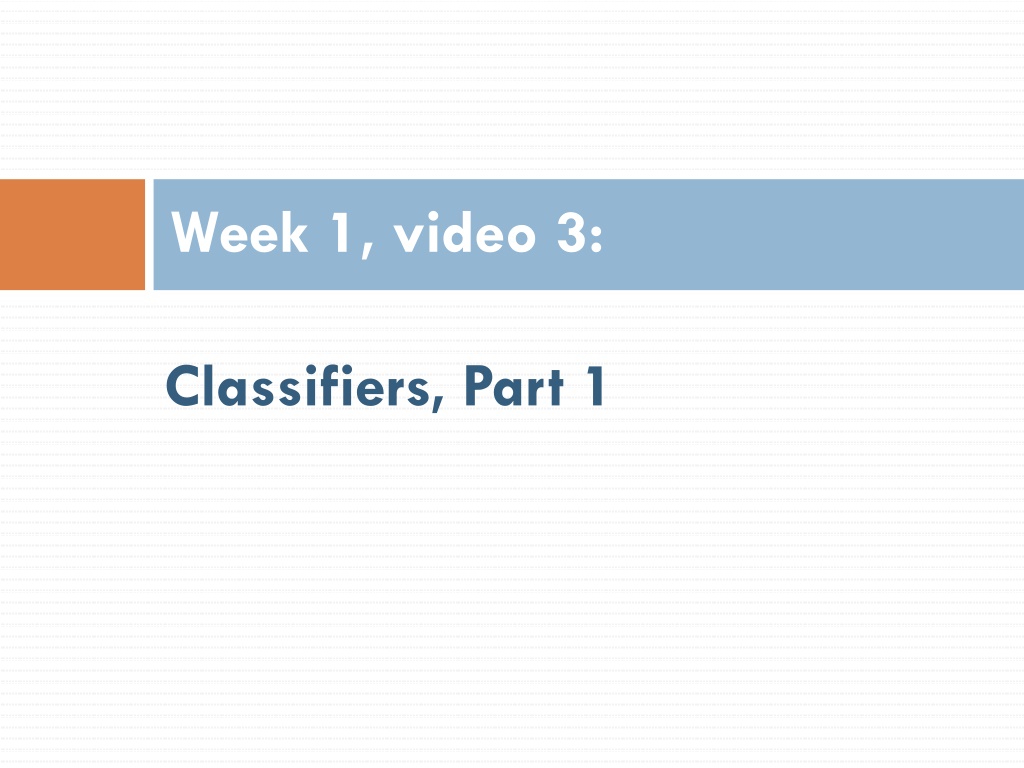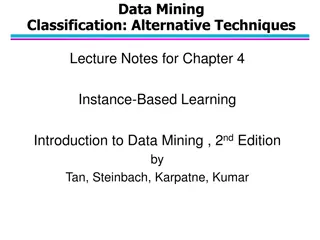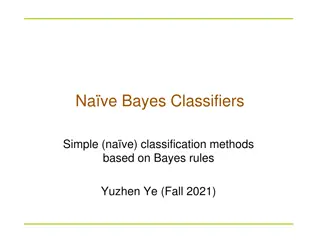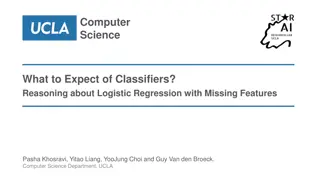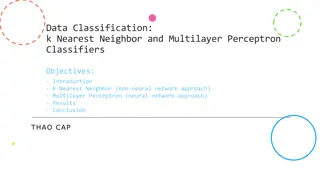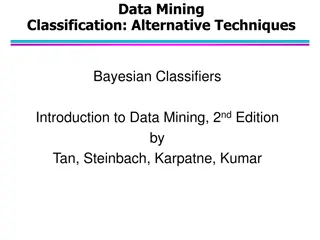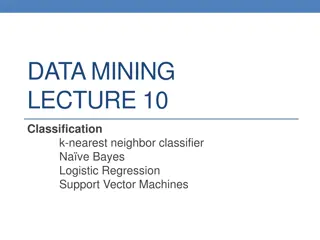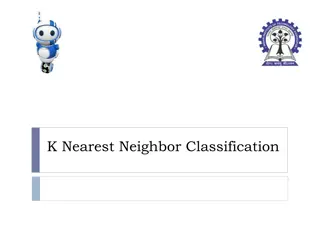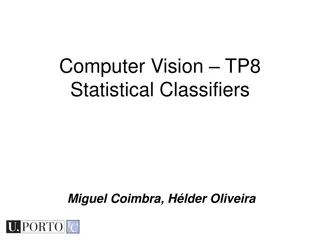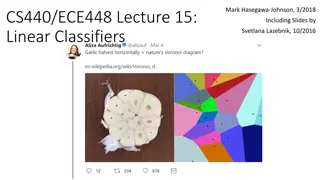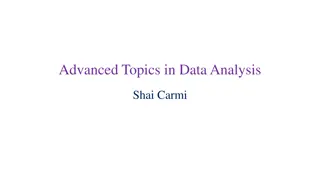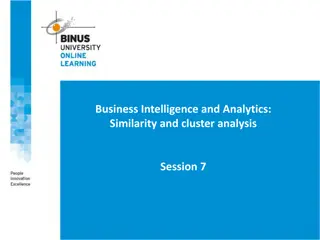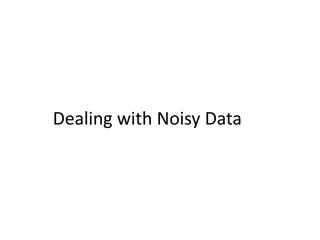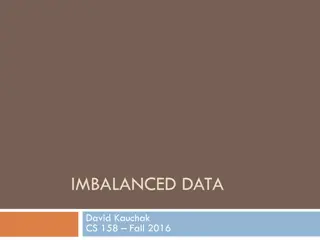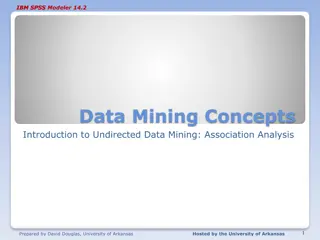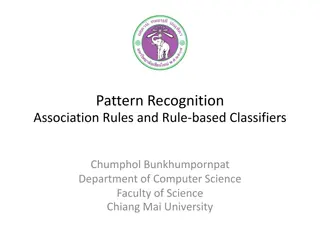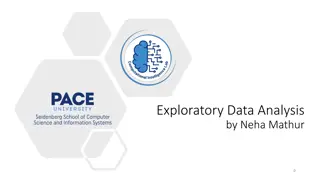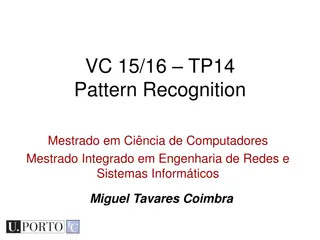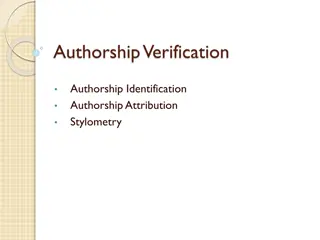Understanding Classifiers in Data Analysis
In data analysis, classifiers play a crucial role in predicting categorical outcomes based on various features within the data. Through models and algorithms, classifiers can be used to make predictions about the future or infer present situations. Various classification methods and techniques are explored, ranging from traditional algorithms to neural networks, providing a deeper understanding of how data can be leveraged to make informed decisions.
Download Presentation

Please find below an Image/Link to download the presentation.
The content on the website is provided AS IS for your information and personal use only. It may not be sold, licensed, or shared on other websites without obtaining consent from the author. Download presentation by click this link. If you encounter any issues during the download, it is possible that the publisher has removed the file from their server.
E N D
Presentation Transcript
Week 1, video 3: Classifiers, Part 1
Prediction Develop a model which can infer a single aspect of the data (predicted variable) from some combination of other aspects of the data (predictor variables) Sometimes used to predict the future Sometimes used to make inferences about the present
Classification There is something you want to predict ( the label ) The thing you want to predict is categorical The answer is one of a set of categories, not a number CORRECT/WRONG (sometimes expressed as 0,1) We ll talk about this specific problem later in the course within latent knowledge estimation HELP REQUEST/WORKED EXAMPLE REQUEST/ATTEMPT TO SOLVE WILL DROP OUT/WON T DROP OUT WILL ENROLL IN MOOC A,B,C,D,E,F, or G
Where do those labels come from? In-software performance School records Test data Survey data Field observations or video coding Text replays
Classification Associated with each label are a set of features , which maybe you can use to predict the label Skill ENTERINGGIVEN ENTERINGGIVEN USEDIFFNUM ENTERINGGIVEN REMOVECOEFF REMOVECOEFF USEDIFFNUM . pknow 0.704 0.502 0.049 0.967 0.792 0.792 0.073 time 9 10 6 7 16 13 5 totalactions 1 2 1 3 1 2 2 right WRONG RIGHT WRONG RIGHT WRONG RIGHT RIGHT
Classification The basic idea of a classifier is to determine which features, in which combination, can predict the label Skill ENTERINGGIVEN ENTERINGGIVEN USEDIFFNUM ENTERINGGIVEN REMOVECOEFF REMOVECOEFF USEDIFFNUM . pknow 0.704 0.502 0.049 0.967 0.792 0.792 0.073 time 9 10 6 7 16 13 5 totalactions 1 2 1 3 1 2 2 right WRONG RIGHT WRONG RIGHT WRONG RIGHT RIGHT
Classification Of course, usually there are more than 4 features And more than 7 actions/data points
Classifiers There are hundreds of classification algorithms you can choose Largely, they boil down into neural networks and classic algorithms Neural networks have been around for a long time, but they got a lot better a few years ago Some more recent algorithms such as XGBoost get treated as classic too
Some popular classic algorithms Logistic Regression (and close relatives like LASSO) Decision Trees (J48/C4.5/CART) Random Forest XGBoost There are many others! For a fuller selection of classic algorithms, see the previous editions of this textbook
Step Regression Not step-wise regression Used for binary classification (0,1) Rarely used anymore, but I m discussing it because it s a building block to other concepts
Step Regression Fits a linear regression function (as discussed in previous video) with an arbitrary cut-off Selects parameters Assigns a weight to each parameter Computes a numerical value Then all values below 0.5 are treated as 0, and all values >= 0.5 are treated as 1 Important: you can use a different cut-off than 0.5!
Example Y= 0.5a + 0.7b 0.2c + 0.4d + 0.3 Cut-off 0.5 a b c d Y 1 1 1 1 0 0 0 0 -1 -1 1 3
Example Y= 0.5a + 0.7b 0.2c + 0.4d + 0.3 Cut-off 0.5 a b c d Y 1 1 1 1 1 0 0 0 0 -1 -1 1 3
Example Y= 0.5a + 0.7b 0.2c + 0.4d + 0.3 Cut-off 0.5 a b c d Y 1 1 1 1 1 0 0 0 0 0 -1 -1 1 3
Example Y= 0.5a + 0.7b 0.2c + 0.4d + 0.3 Cut-off 0.5 a b c d Y 1 1 1 1 1 0 0 0 0 0 -1 -1 1 3 0
Quiz Y= 0.5a + 0.7b 0.2c + 0.4d + 0.3 Cut-off 0.5 a b c d Y 2 -1 0 1
Logistic Regression Another algorithm for binary classification (0,1)
Logistic Regression Given a specific set of values of predictor variables Fits logistic function to data to find out the frequency/odds of a specific value of the dependent variable
Logistic Regression p(m) 1.2 1 0.8 0.6 0.4 0.2 0 -4 -3 -2 -1 0 1 2 3 4
Logistic Regression m = a0 + a1v1 + a2v2 + a3v3 + a4v4
Logistic Regression m = 0.2A + 0.3B + 0.4C
Logistic Regression m = 0.2A + 0.3B + 0.4C A B C M P(M) 0 0 0
Logistic Regression m = 0.2A + 0.3B + 0.4C A B C M P(M) 0 0 0 0 0.5
Logistic Regression m = 0.2A + 0.3B + 0.5C A B C M P(M) 1 1 1 1 0.73
Logistic Regression m = 0.2A + 0.3B + 0.5C A B C M P(M) -1 -1 -1 -1 0.27
Logistic Regression m = 0.2A + 0.3B + 0.5C A B C M P(M) 2 2 2 2 0.88
Logistic Regression m = 0.2A + 0.3B + 0.5C A B C M P(M) 3 3 3 3 0.95
Logistic Regression m = 0.2A + 0.3B + 0.5C A B C M P(M) 50 50 50 50 ~1
Relatively conservative Thanks to simple functional form, is a relatively conservative algorithm I ll explain this in more detail later in the course
Good for Cases where changes in value of predictor variables have predictable effects on probability of predicted variable class m = 0.2A + 0.3B + 0.5C Higher A always leads to higher probability But there are some data sets where this isn t true!
What about interaction effects? A = Bad B = Bad A+B = Good
What about interaction effects? Ineffective Educational Software = Bad Off-Task Behavior = Bad Ineffective Educational Software PLUS Off-Task Behavior = Good
Logistic and Step Regression are good when interactions are not particularly common Can be given interaction effects through automated feature distillation We ll discuss this later But is not particularly optimal for this
What about interaction effects? Fast Responses + Material Student Already Knows - > Associated with Better Learning Fast Responses + Material Student Does not Know - > Associated with Worse Learning
Decision Trees An approach that explicitly deals with interaction effects
Decision Tree KNOWLEDGE <0.5 >=0.5 TIME TOTALACTIONS <6s. >=6s. <4 >=4 RIGHT WRONG RIGHT WRONG Skill COMPUTESLOPE knowledge 0.544 time 9 totalactions 1 right? ?
Decision Tree KNOWLEDGE <0.5 >=0.5 TIME TOTALACTIONS <6s. >=6s. <4 >=4 RIGHT WRONG RIGHT WRONG Skill COMPUTESLOPE knowledge 0.544 time 9 totalactions 1 right? RIGHT
Decision Tree KNOWLEDGE <0.5 >=0.5 TIME TOTALACTIONS <6s. >=6s. <4 >=4 RIGHT WRONG RIGHT WRONG Skill COMPUTESLOPE knowledge 0.444 time 9 totalactions 1 right? ?
Decision Tree Algorithms There are several Decision Tree classifiers that are decent: C4.5/J48, CART are good choices You already saw REPTree and M5 as Decision Tree regressors (previous video) Decision Trees are the basis of more sophisticated algorithms like Random Forest and XGBoost (next video) Relatively conservative by themselves, making them more robust to changes in conditions than other algorithms (see Levin et al., 2022)
Good when data has natural splits 16 14 12 10 8 6 4 2 20 0 1 2 3 4 5 6 7 8 9 10 11 18 16 14 12 10 8 6 4 2 0 1 2 3 4 5 6 7 8 9 10 11
Good when multi-level interactions are common
Good when same construct can be arrived at in multiple ways A student is likely to drop out of college when he Starts assignments early but lacks prerequisites OR when he Starts assignments the day they re due
What variables should you use? In one sense, the entire point of data mining is to figure out which variables matter But some variables have more construct validity or theoretical justification than others using those variables generally leads to more generalizable models We ll talk more about this in a future lecture
What variables should you use? In one sense, the entire point of data mining is to figure out which variables matter More urgently, some variables will make your model general only to the data set where they were trained These should not be included in your model They are typically the variables you want to test generalizability across during cross-validation More on this later
Example Your model of student off-task behavior should not depend on which student you have If student = BOB, and time > 80 seconds, then This model won t be useful when you re looking at totally new students
Example Your model of student off-task behavior should not depend on which college the student is in If school = University of Pennsylvania, and time > 80 seconds, then This model won t be useful when you re looking at data from new colleges
Note In modern statistics, you often need to explicitly include these types of variables in models to conduct valid statistical testing This is a difference between classification and statistical modeling We ll discuss it more in future lectures
Later Lectures More classification algorithms Goodness metrics for comparing classifiers Validating classifiers for generalizability What does it mean for a classifier to be conservative?
Next Lecture More advanced/modern classifiers
